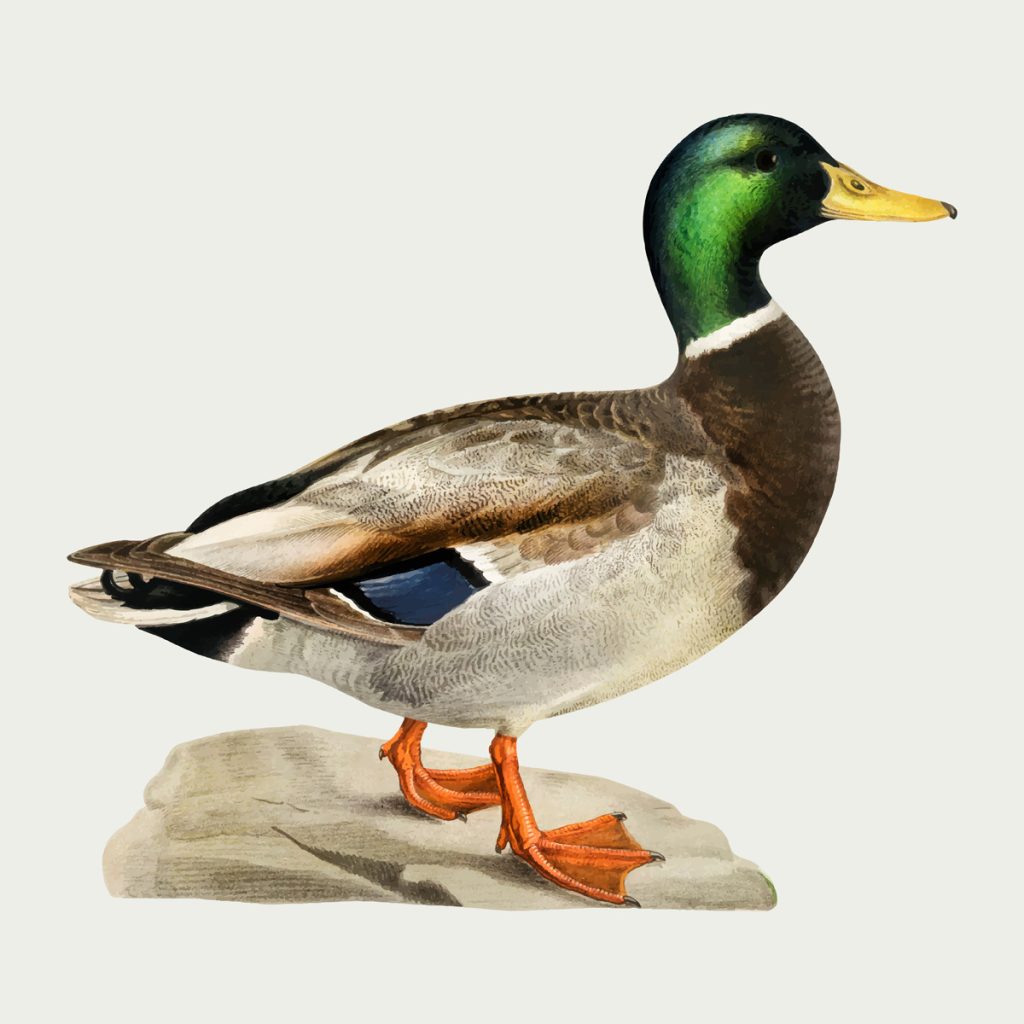Mallard ducks (Anas platyrhynchos) are one of the most widely recognized and studied species of waterfowl. Known for their distinctive coloration, these ducks are found in a broad range of habitats across the northern hemisphere. From urban ponds to remote wetlands, mallards have adapted to an impressive variety of environments. Due to their ability to cross-breed and produce fertile offspring, they are the ancestor of nearly every species of domestic duck.
Mallard ducks are medium-sized waterfowl with sexual dimorphism—meaning males and females display distinct physical differences. Male mallards, or drakes, are easily identifiable by their striking iridescent green head, bright yellow bill, and chestnut-brown breast. In contrast, females are generally brown and mottled, which provides excellent camouflage during nesting, an important survival trait. Both sexes have a distinctive white ring around their necks and a flash of blue on their wings, visible during flight. The mallard’s body is streamlined for efficient swimming, with webbed feet that allow them to propel themselves easily through water.
Their strong wings make them capable of long migratory flights, reaching speeds of up to 55 miles per hour across migratory paths over 700 miles long. In fact, GPS trackers have tracked mallards traveling 500 miles in just four days! In the colder months, they migrate southward to warmer regions. Recent studies have shown that mallard migration routes are influenced not only by weather patterns but also by changes in the availability of food and water.
Mallards are highly adaptable in their choice of habitats. They are commonly found in freshwater lakes, ponds, rivers, marshes, and estuaries. They are also frequently seen in urban areas, where they have learned to thrive in parks, golf courses, and on man-made bodies of water, such as golf course ponds. Mallards are omnivorous, with a diet that varies depending on the season and available resources. They are known to forage for food by dabbling in the water, but they will also graze on grass and feed on insects, small fish, and seeds.
Mallard ducks are known for their relatively simple, yet fascinating, reproductive strategies. During the breeding season, males will court females with a series of ritualized displays, including head-bobbing and a series of vocalizations. After successful mating, the female usually builds a nest in tall grass or reeds, where she lays anywhere from 5 to 12 eggs. The incubation period lasts about 28 days, after which the ducklings hatch and are precocial, meaning they are born with their eyes open and are capable of walking and swimming within hours.
A recent study in the peer-reviewed journal “Animal Behaviour” highlighted the importance of maternal care in the survival of mallard ducklings. The research found that mothers who remained close to their ducklings in the early days after hatching had a significantly higher survival rate for their offspring compared to those who did not. The study also emphasized the ducks’ ability to navigate through urban environments, where natural predators may be more scarce but other challenges, such as traffic, can pose significant risks.
Mallards play an essential role in maintaining the health of wetland ecosystems. As omnivores, they help control the populations of small aquatic invertebrates and plants, which in turn affects the balance of the food web.
Furthermore, their droppings contribute nutrients to the surrounding soil and water, enriching the environment for other species. In some regions, however, mallard populations have increased dramatically, leading to concerns about their impact on other species. Their ability to thrive in altered or human-dominated landscapes has made them an invasive species in South Africa, Hawaii, New Zealand, and Australia, displacing native waterfowl and altering local ecosystems. Mallards pose a unique risk to native duck populations due to their ability to produce fertile offspring with other species. In Florida, for example, owning a mallard is banned in order to protect the native mottled duck.
Mallards’ adaptability to various environments and ability to breed prolifically have helped their population remain stable. However, the species does face threats from habitat loss, pollution, and climate change. The destruction of wetlands—whether through urban development or agricultural expansion—has reduced the availability of critical nesting sites, pushing more mallards into urban areas. While these domesticated mallards have become dependent on humans for food, consider feeding them something other than bread, as this can cause digestive issues. Instead, opt for frozen peas or corn, which is closer to what they would eat in the wild, and more nutritious.

Eagle Nest Lake How to get there: Head toward Eagles Nest along US 64. Keep an eye out for Angel Nest RV retreat in Eagles Nest, and turn onto the road next to it: B11 B/ Marina Way. The lake is at the end of the road. No cost.
Lost Lake Trail Located between Red River and Eagle Nest, this intermediate trail is also a great fishing spot as it’s stocked via helicopter with native cutthroat trout. Birds that shelter in aspen and spruce trees will be here. How to get there: Travel south about 6 miles on NM 578 to the junction of Middle Fork and East Fork. The pavement ends here. Take the road to the right, Forest Road 58, for approximately 1.1 miles to a parking area. No turnaround or parking is available beyond this point. No cost.
Goose Lake Trail A moderate trail that climbs 5.5 miles to Goose Lake and is also accessible via ATV. Alpine inclined birds will be found foraging here. How to get there: Travel 2.5 miles up NM 578. Look for the trailhead on the west side. No cost.
Birding Checklist
Raptors
- Bald Eagle
- Northern Harrier
- Great Horned Owl
- Red Tailed Hawk
- Rough Legged Hawk
Songbirds
- Clark’s Nutcracker
- Western Meadowlark
- Lewis’ Woodpecker
- Evening Grosbeak
- Cedar Waxwing
Waterfowl
- Gadwall
- Ring-Necked Duck
- Common Goldeneye
- American Coot
- Common Merganser
Author
-

Bryce Flanagan moved from Sacramento, CA to Taos County in 2016, and has lived in Questa for two years. He's passionate about the unique and beautiful wildlife of our state and is a regular contributor to the Questa Del Rio News.
View all posts


